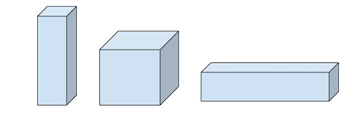by Andy Bell
I observed another math class last week where students were learning about the volume of prisms. They were shown three rectangles in two dimensions, one small, one medium, and one large. Then the teacher asked "If these rectangles were extended up, out of the paper, in three dimensional space and all three resulting prisms had the same volume, which would be the tallest and which would be the shortest?"

I love questions like this that make people visualize shapes and movements in their heads. It's a great brain exercise. Even if you're not good at visualizing things like this it's good to get the exercise. Most of the students were able identify that the smallest rectangle would produce the tallest prism and visa versa.

A question that I've asked recently to help start a conversation is "Why can't we divide a small number by a large number?" I try to help students formulate a reason for a math rule to exist rather than just telling them what the rules are. Usually they respond with frustration at first because they're expecting an answer from me, not a question. Hopefully they re-think what they know about dividing numbers however, and either alter their understanding to accommodate new information or find reason why it's impossible. Either way the understanding is deeper because it is personal.